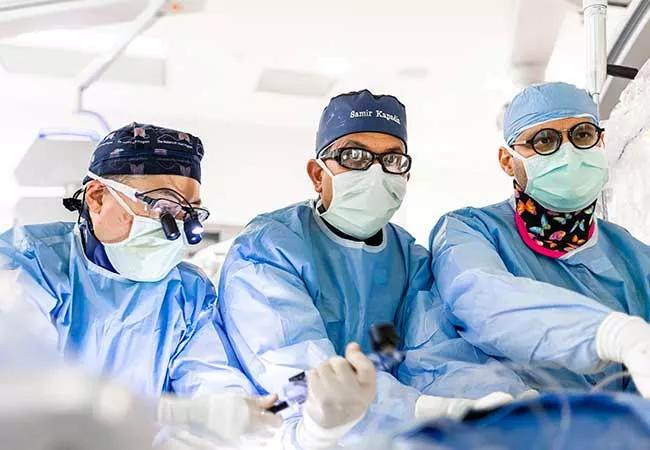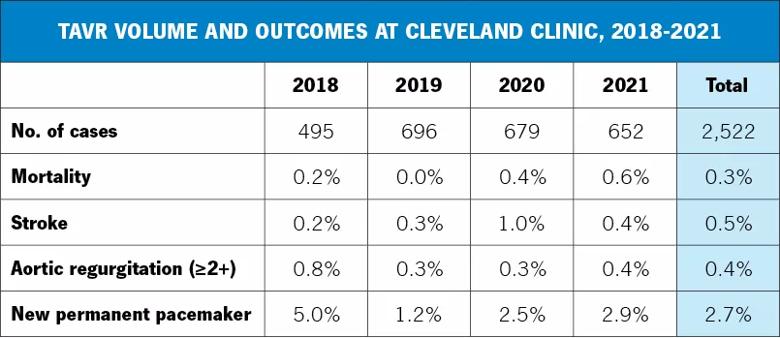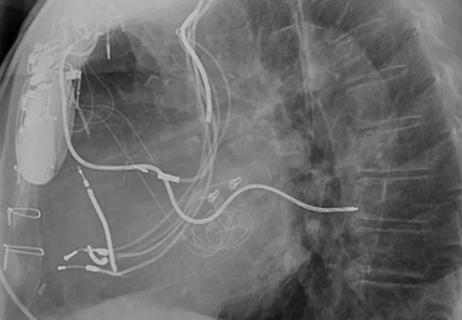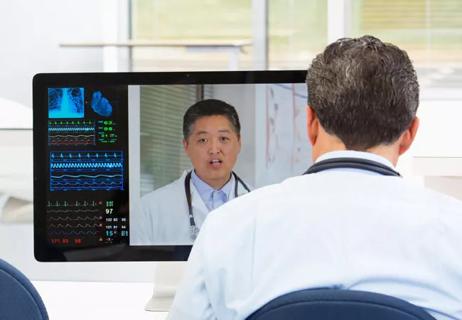How and why we are replicating our TAVR protocol across our U.S. and international sites

When it comes to transcatheter aortic valve replacement (TAVR), what happens in Cleveland shouldn’t stay in Cleveland. That’s the attitude Cleveland Clinic’s Heart, Vascular & Thoracic Institute has taken toward promoting experience-based best practices to meet growing demand for this practice-changing percutaneous procedure.
Cleveland Clinic is a non-profit academic medical center. Advertising on our site helps support our mission. We do not endorse non-Cleveland Clinic products or services. Policy
“Since we started performing TAVR on an investigational basis in 2006 at our main campus in Cleveland, we have fine-tuned our practices and processes over thousands of subsequent procedures here,” says interventional cardiologist Samir Kapadia, MD, Chair of Cardiovascular Medicine at Cleveland Clinic. “As Cleveland Clinic grows as a health system, both nationally and internationally, we are ensuring that those practices and processes get replicated at all other sites where we offer TAVR so that every patient can expect the very same safety, quality and outcomes, regardless of where they undergo the procedure.”
The fine-tuning Dr. Kapadia refers to started yielding results from the earliest days. “We performed 262 transfemoral TAVRs in our first six years of doing the procedure, with no deaths,” he notes. “This was at a time when mortality was nearly 10% elsewhere. There were complications and difficulties, but we were prepared to deal with the difficulties in an expeditious and effective manner.”
Key to that preparedness has been the TAVR team’s multidisciplinary nature from the start. “An important part of the TAVR program’s success over time has been the collegial relationship between the cardiology and surgical members of the TAVR team, beginning with patient evaluation and including procedural collaboration,” says cardiothoracic surgeon James Yun, MD, PhD, a longtime member of the main campus TAVR team. “The presence of experienced cardiac surgeons invested in the TAVR team during the TAVR procedure directly contributes to patient safety not only by adding experienced hands and eyes to the procedure, but also by ensuring immediate surgeon availability when seconds count.”
Drs. Kapadia and Yun note that the team continued to refine its TAVR protocol even after the TAVR program’s successful early years. And they had more and more experience to draw from after TAVR gained initial FDA approval for commercial use in late 2011 and accumulated additional indications in broader patient populations in the following years. “We continually analyze our results and make adjustments accordingly to best decide which valves to use, how to properly size and deploy them, and how best to evaluate patients in a multidisciplinary heart team format,” Dr. Yun observes.
The outcomes data in the table below — among the most favorable of any TAVR program anywhere — are a testament to this approach. They also argue for disseminating Cleveland Clinic’s TAVR practices in order to promote improved outcomes more broadly.

“We have aimed to do that by sharing insights from our experience beyond Cleveland Clinic through a series of peer-reviewed papers describing and documenting some of our best practices around TAVR,” notes Dr. Kapadia. These papers have covered such issues as:
Additionally, within the realm that Cleveland Clinic’s main campus TAVR team can influence most directly — other hospitals in the expansive Cleveland Clinic health system — they are disseminating their TAVR practices by intimately exposing their colleagues at other locations to exactly how TAVR is done at Cleveland Clinic’s main campus and then providing support and resources to enable them to replicate those processes at their sites.
The effort has taken place close to home — several years ago at Cleveland Clinic Akron General, which is 40 miles south of Cleveland and joined the Cleveland Clinic health system in late 2015 — and further afield, at Cleveland Clinic Florida in Southeast Florida as well as internationally. On the international front, TAVR is well established at Cleveland Clinic Abu Dhabi in the United Arab Emirates and at Cleveland Clinic London, which swiftly established the busiest private TAVR program in the United Kingdom within weeks of opening its inpatient program in spring 2022.
“The aim has been to analyze our TAVR data and understand our results, and then to build similar TAVR teams and care systems at other locations,” Dr. Kapadia explains. “That means ensuring that any TAVR procedure we offer involves proper patient selection, proper patient evaluation by a multidisciplinary team (including cardiac surgery, cardiology, cardiovascular imaging), proper execution of the procedure, and proper discharge mechanisms and follow-up. And it all has to be done safely and in a value-based way that is financially sustainable.”
The effort involves a multifaceted process. Typically, teams from the other Cleveland Clinic locations — including physician, nursing and database team representatives — visit the main campus to spend time with and observe the TAVR team during procedures. The visit also exposes them to how the interdisciplinary main campus team collaboratively evaluates TAVR candidates and advises them on transcatheter versus surgical AVR. And it provides exposure to the main campus team’s record-keeping system as well as its infrastructure and processes for TAVR data collection.
When the new site is ready to start TAVR procedures, interventional cardiologists from the main campus TAVR team will go to the new site and perform procedures for several days, observe the new team doing procedures and be available to field questions. Additionally, video systems have been set up to allow the main campus team to observe TAVR procedures at other sites via livestream and advise on procedural questions as needed. “This system has allowed highly skilled operators at other sites in the enterprise to fine-tune their care, even in real time, to provide the most up-to-date procedures and results through collaboration,” says Amar Krishnaswamy, MD, Section Head of Interventional Cardiology at Cleveland Clinic’s main campus.
On an ongoing basis, the main campus TAVR team takes questions about challenging cases and reviews all other sites’ TAVR data and outcomes, offering advice when requested. As it does for other major cardiovascular procedures, Cleveland Clinic has set up a dashboard so its Heart, Vascular & Thoracic Institute leaders can review TAVR-related data at the enterprise level, allowing them to flag any issues and follow up with a given site as needed.
TAVR teams at other sites also may make periodic visits to Cleveland to keep current. “We try to visit the main campus for a week every year to learn the latest optimal techniques,” says Mahmoud Traina, MD, a staff cardiologist with the TAVR team at Cleveland Clinic Abu Dhabi. “We always learn small improvements in technique that we bring back to our patients in Abu Dhabi. For example, we have optimized our technique to include single-sided access, higher valve implantation and single-device closure to achieve similarly low rates of complications to serve as the benchmark for our region.”
Key to enterprise-level TAVR integration is the standardization of record-keeping and database practices. “Sometimes definitions can be tricky,” Dr. Kapadia explains. “So we ensure that all our sites are using the same definitions, such as how to define procedural start and finish times and what constitutes a readmission. This promotes apples-to-apples comparisons when we combine our data across sites, and it makes it easier to analyze data and advance quality initiatives. This is important, as our Heart, Vascular & Thoracic Institute makes a point of publicly reporting outcomes encompassing every patient we treat.”
The integration of every new TAVR site involves its own special circumstances. Heart, Vascular & Thoracic Institute leadership from Cleveland was involved in recruiting staff specifically for launching TAVR programs at Cleveland Clinic Akron General and Cleveland Clinic Florida. Leaders from Cleveland also advised on the redesign of hybrid operating rooms at both sites to best accommodate the Cleveland Clinic approach to TAVR.
“The Heart, Vascular & Thoracic Institute’s commitment to developing a world-class TAVR program at Cleveland Clinic Akron General has brought life-changing and lifesaving capability close to home for countless residents of Akron and communities south of Cleveland,” says Akron General cardiothoracic surgeon Joseph Lahorra, MD. “Our Cleveland colleagues used a ‘team of teams’ approach by opening their labs and meeting room doors to our TAVR team, as well as operating with us in Akron, to fully share their experience and expertise. The result has been outstanding outcomes, as there have been no TAVR mortalities since the inception of the program here in 2019. We are in constant communication with the team in Cleveland to review challenging or higher-risk cases to determine the best approach and treatment venue.”
The enterprise-wide integration of TAVR programs also extends to research efforts for sites within the U.S. For example, it has allowed Cleveland Clinic to enroll patients in several TAVR-related clinical trials at its Akron General and Cleveland Clinic Florida hospitals in addition to its main campus site, promoting more extensive and effective contributions to research protocols.
“Being part of our enterprise’s integrated TAVR program provides access to advanced technologies and expands the cohort of patients who can benefit from this lifesaving therapy,” says cardiologist Emad Hakemi, MD, of Cleveland Clinic Florida in Weston, Florida. “This has translated to access to cerebral protection devices, postprocedural prolonged rhythm monitoring protocols and the capacity to offer our patients access to important clinical trials, such as TAVR UNLOAD, EARLY TAVR and others.”
And the expansion of the Cleveland Clinic TAVR model to new sites is an opportunity for learning all around, as was the case when Cleveland Clinic London started doing TAVRs after its opening this past spring. “The London team is highly experienced, so it was rewarding for me to be exposed to some European nuances of TAVR when I spent a few days with them in London sharing our systems and processes,” says Dr. Kapadia.
“We greatly value the collaboration with our colleagues in Cleveland and are always keen to streamline our procedural protocols and care pathways to ensure the best outcomes for patients,” says Professor Bernard Prendergast, DM, FRCP, Chair of Cardiology at Cleveland Clinic London, who holds a standing conference with the Cleveland team every two weeks.
The most recent expansions of the model are taking place this summer, as Cleveland Clinic’s Hillcrest and Fairview hospitals — regional hospitals serving Cleveland’s east and west suburbs — begin to offer TAVR following the process outlined in this article.
“This effort empowers TAVR teams at all of our sites with the collective TAVR expertise and resources that the full Cleveland Clinic enterprise has to offer,” Dr. Kapadia observes.
“Making care more regional also allows patients to remain closer to home and to their established support systems, which is especially important when going through a major procedure that carries emotional stress,” adds Dr. Krishnaswamy.
“Sharing the knowledge and expertise of both our cardiologists and surgeons in this way ensures that patients can be confident they will receive the highest standards of Cleveland Clinic treatment regardless of which location they choose for their TAVR care,” Dr. Yun concludes.

Nursing leaders share knowledge, ideas and experience

Freely accessible LEADconnection.org is a one-stop shop for advice and more

Scoping review implicates temperature extremes, air pollutants, expanding infectious disease risk

Reforms aim to address escalating healthcare spending with new global care-delivery strategies

Program extends Cleveland Clinic’s commitment to global education and healthcare

Cleveland Clinic reinforces operating model for international patient-centered growth

How an idea forged in war transformed healthcare around the world

Cleveland Clinic’s Virtual Second Opinions program has been refined